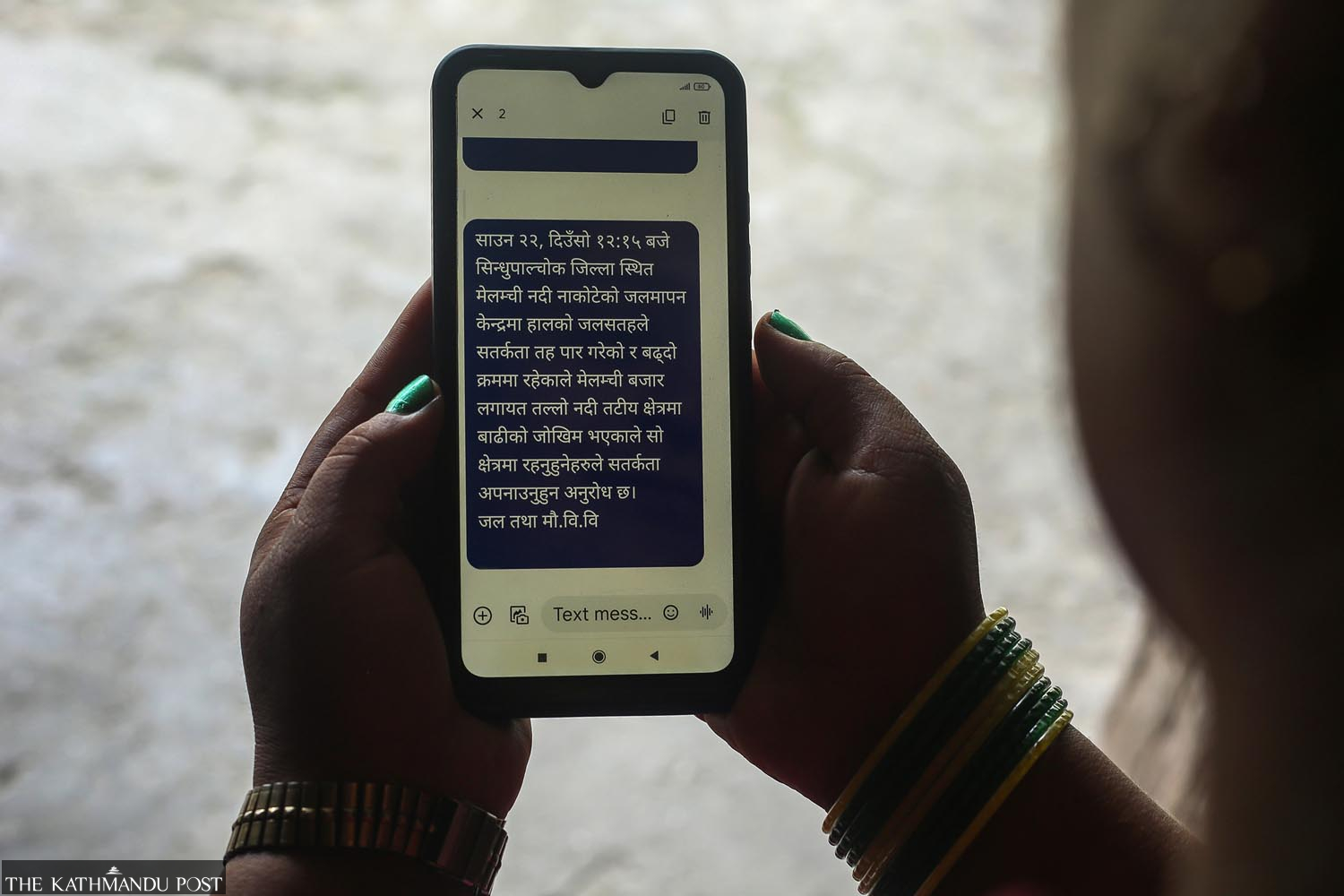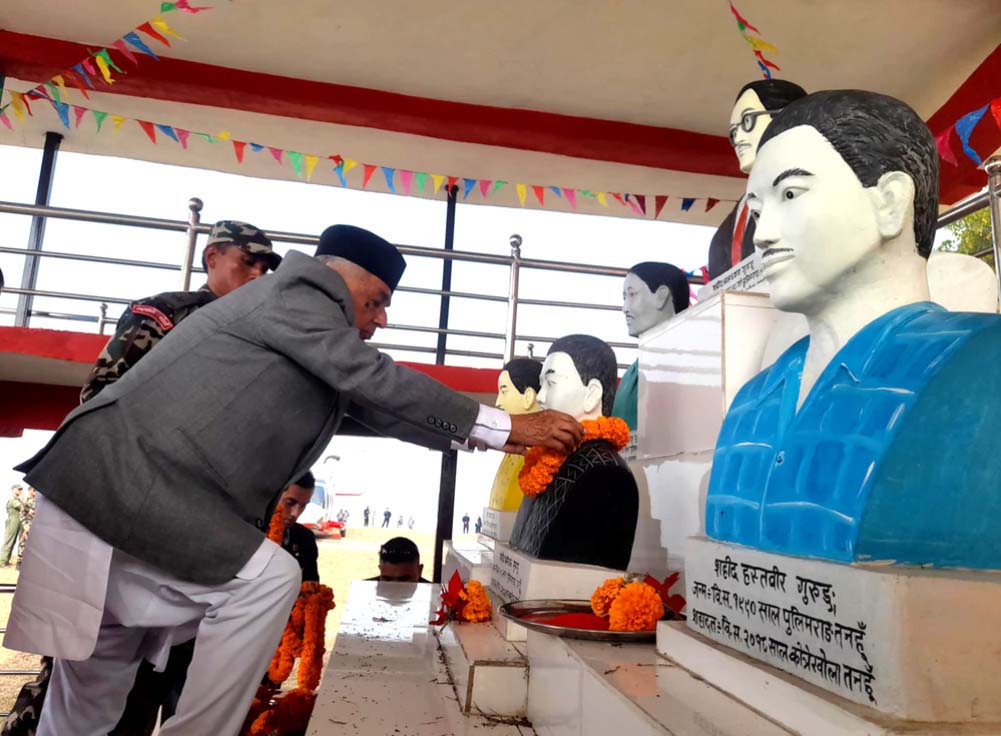Visual Stories
Early warning system saves lives
In Sindhupalchok’s flood-prone areas, an early warning system alerts residents to escape in time.Yet, the losses from past devastation remain immeasurable for many as they look to rebuild.
Prakash Chandra Timilsena
Labouring in the fields all day and enjoying a cosy sleep at night is Prem Bahadur Danuwar’s routine from Melamchi Municipality-9, Sindhupalchowk. June 30 started like any other day. However, in the middle of the night, his sleep was suddenly interrupted by the ringing of his mobile phone. Half-asleep, he reached for the phone under his pillow. The caller was Kedar Karki, a fellow villager. A worrying thought crossed his mind—had some illness or trouble befallen the village?
When Danuwar picked up the phone, a panicked voice said, "Uncle, a big flood is coming. Be careful." Instantly, images of Melamchi's devastation from the flood of 2021 flashed before his eyes.
"After hearing that disaster was heading toward my house, panic set in," Danuwar says. "I ended the call and found myself lost in memories of the desolate Melamchi from three years ago." He recounted, "I tried to wake my wife and daughter, but then got another call—‘Uncle, run away quickly.’ We rushed to the hill, and in moments, our home and farmland were swept away. If we had been any later, the flood would have taken us too."

Danuwar invested one million in an organic farm growing mushrooms, cucumbers, tomatoes, and bitter greens. He used his lifetime savings for the four ropani land, including two ropani he rented.
"People used to say a big disaster comes every hundred years, but it came just three years later in Melamchi. Last time, my house was spared, but the flood took everything this time," he recalls sadly. Reflecting on his losses, he adds, "I am a victim of disasters, the earthquake, and now, the floods."
Kedar Karki, chairman of the Community Disaster Management Committee for Melamchi Municipality-9, was warned by an acquaintance about an approaching flood. He promptly informed residents along the riverbank. The warning spread through the village, enabling people to reach safety and save their lives.

Efforts have been intensified to prevent further losses in settlements established after the 2021 flood, which claimed 24 lives, damaged 663 houses, and caused Rs84.59 billion in destruction in Helambu Rural Municipality and Melamchi Municipality.
Since 2022, Practical Action has installed climate and rainfall measuring stations at seven sites and river level gauge stations at two locations in Melamchi and Helambu, collaborating with the Department of Hydrology and Meteorology and local government. Across Sindhupalchowk District are now 15 rainfall stations and four river-level gauge stations. Timely alerts from these centres have helped prevent human losses in the affected areas.
Thanks to the timely warnings, Baburam Bhandari's family from Kiul, Helambu Rural Municipality-2, avoided a repeat of the 2021 tragedy. Bhandari had lost his son, Madhav, in the Melamchi flood that year.
On Shrawan 16 of that year, the flood destroyed 12 ropani of land, a water mill, and a newly built buffalo farm with two buffaloes. Recalling that tragic day, 66-year-old Bhandari said, "We had just finished planting on Asadh 1 and were resting in the courtyard. My son Madhav followed our neighbour, Ganesh Sir, to the fish pond by the river. A massive wave suddenly swept him away as they stood at the pond's edge. He might have been saved if a pre-warning system like we have now had existed," Today, when river levels rise, caution messages are sent out, and heavy rain alerts advise people to seek safety immediately.
Thirty-six-year-old Gyanu Giri from Gairibesi, Helambu-4, received a warning message from the Department of Hydrology and Meteorology at 12:55 PM on Shrawan 22. The message stated, "The water level at the Melamchi River's Nakote measuring station is rising, posing a flood risk to lower river areas, including the Melamchi market. Residents are advised to exercise caution."

As a member of the risk reduction initiative, Giri promptly spread the warning to those in high-risk areas and helped rescue people trapped by floods and landslides.
River and flood gauge stations provide real-time data and send SMS alerts to help communities stay alert. However, Sunil Pokhrel, head of the flood forecasting branch and spokesperson of the Hydrology and Meteorological Department, says this system is underdeveloped in the Himalayas, with only 8-9 locations covered. A study suggests expanding to 20-25 more sites. While efforts are being made to extend the system, challenges include limited satellite technology. The system is effective in the Terai, and flood-related human losses are decreasing.
Buddhiman Tamang, ward chairman of Helambu Rural Municipality-4, said early warnings have been crucial for local safety, noting, "While floods persist, these alerts have prevented loss of life," The Department of Hydrology and Meteorology sends warnings to high-risk areas, quickly spreading through the village. To enhance communication and preparedness, locals have established a disaster management committee.









 10.12°C Kathmandu
10.12°C Kathmandu.jpg)





